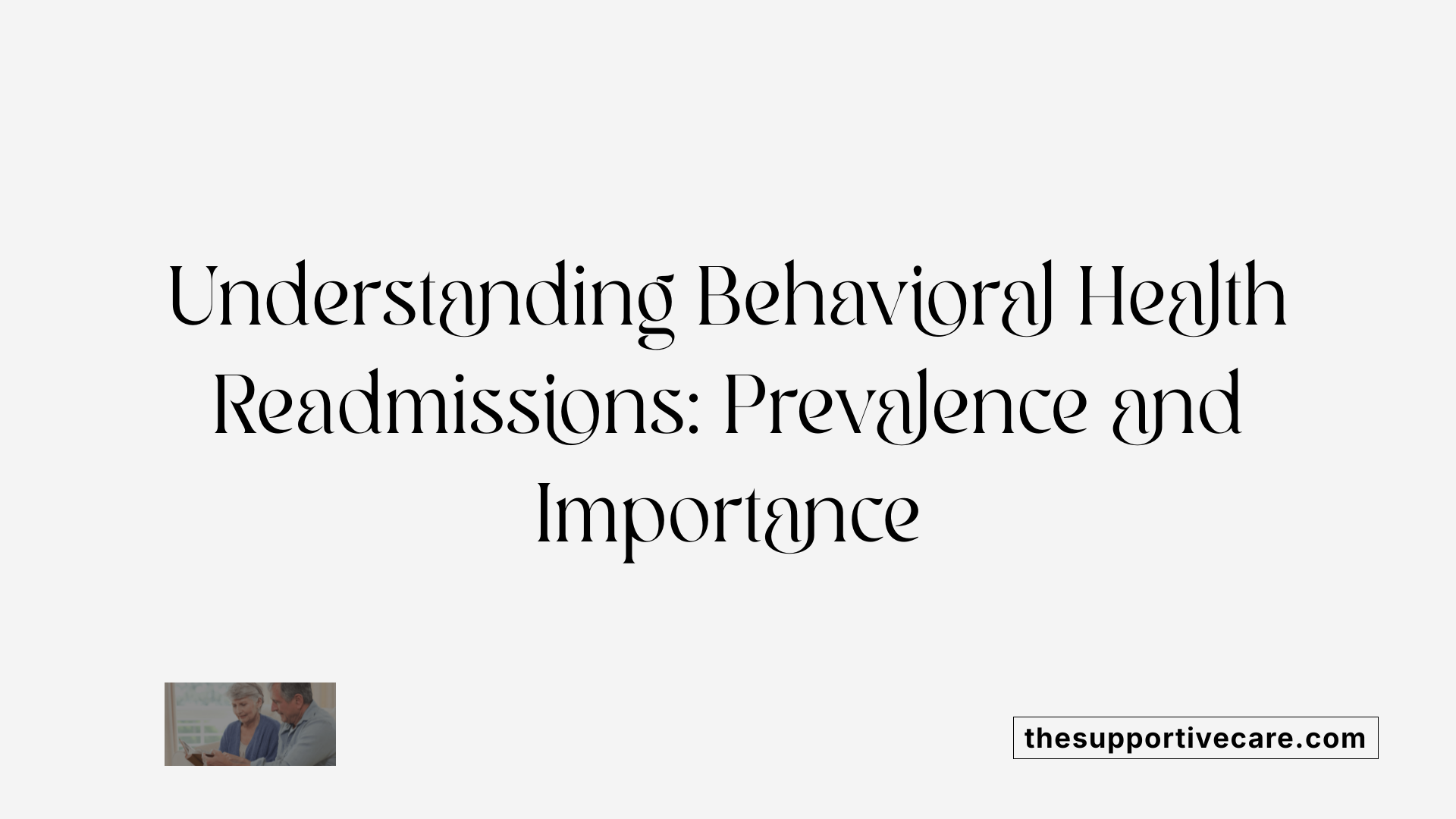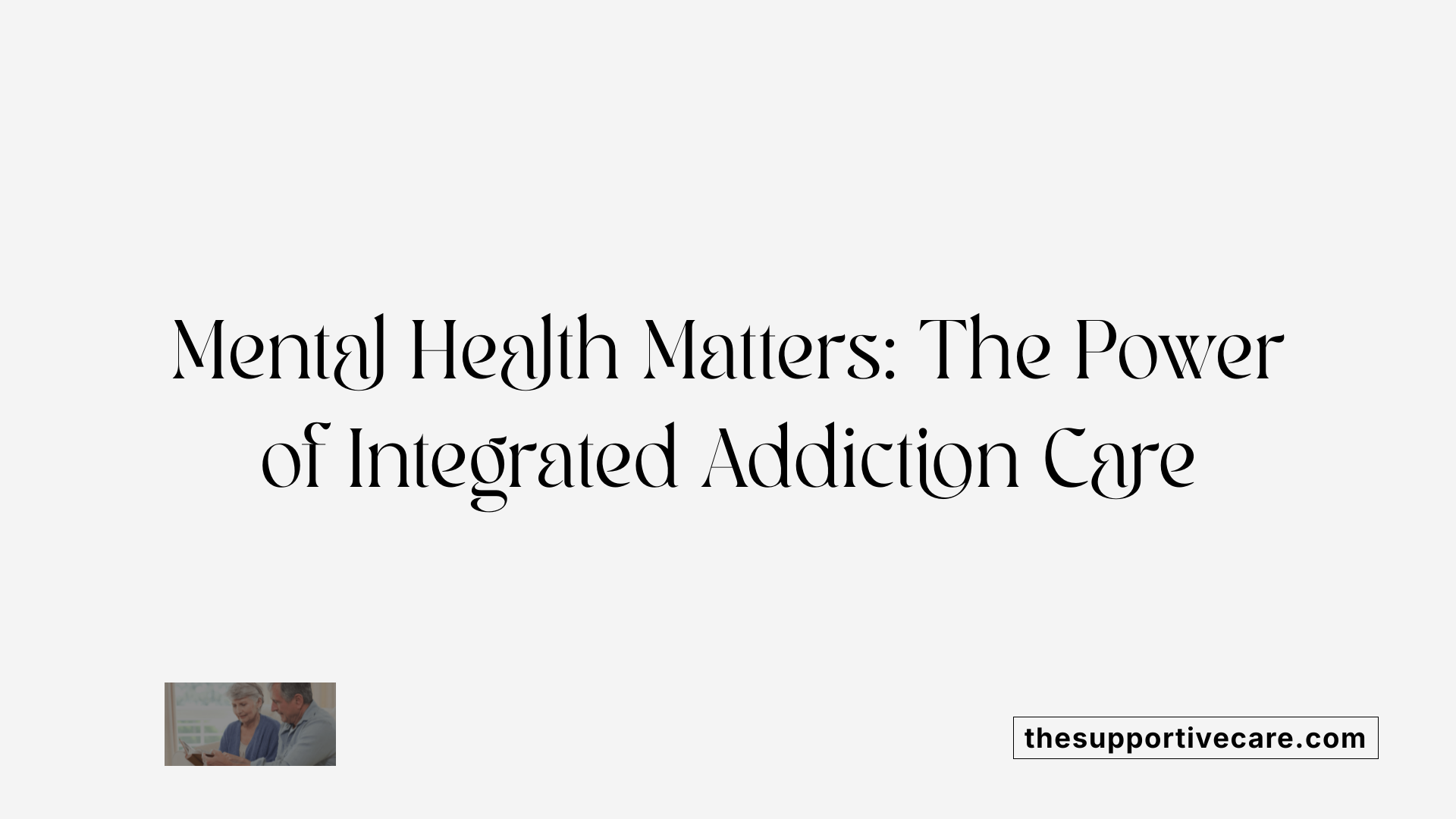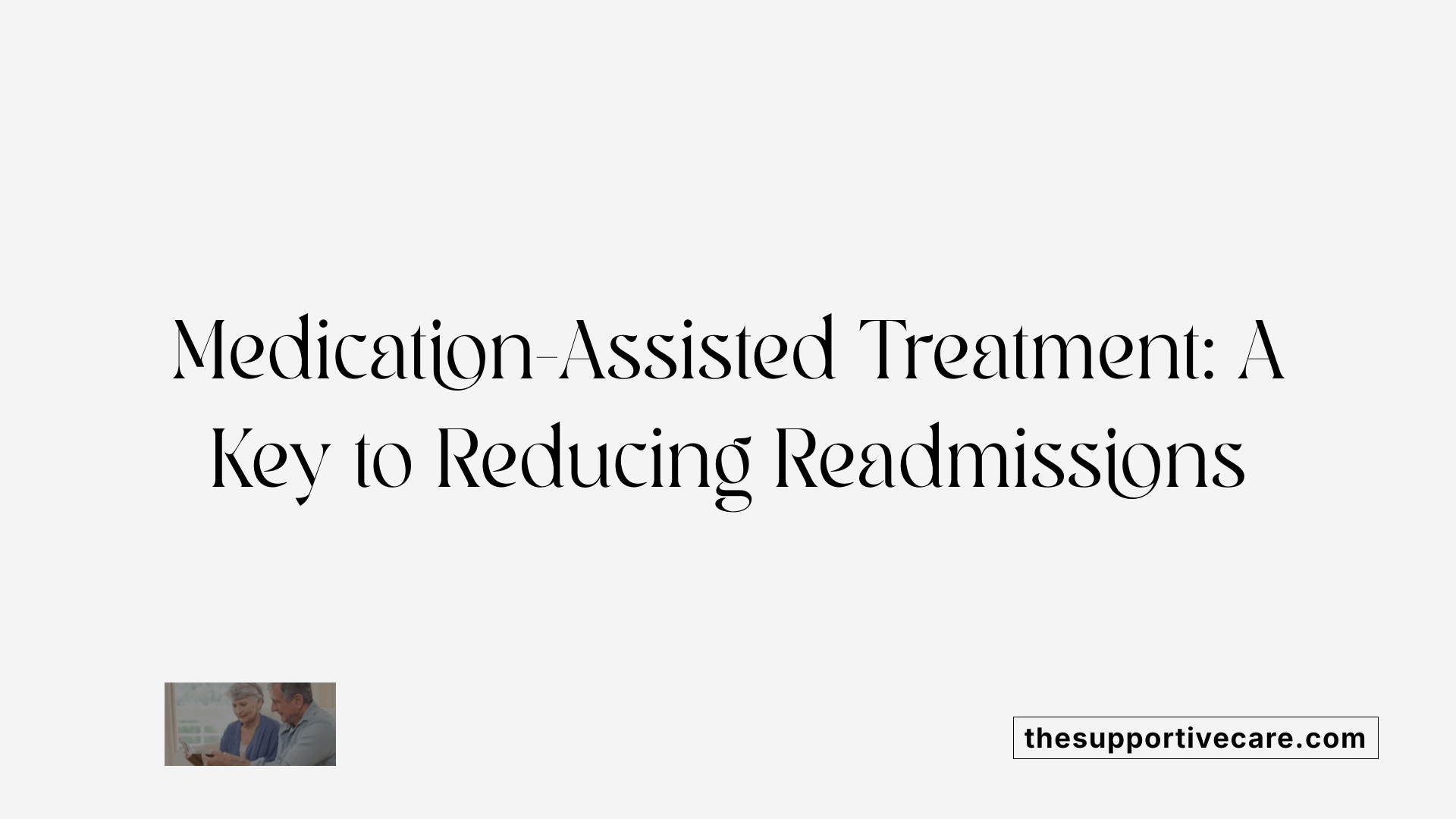Understanding the Challenge of Behavioral Health Readmissions
Behavioral health hospital readmissions pose a significant challenge to healthcare systems and patients alike, with nearly one in three patients being readmitted within 90 days after discharge. These readmissions often reflect gaps in continuity of care, especially for individuals with substance use disorders and co-occurring mental health conditions. This article explores how comprehensive behavioral health services, timely follow-up care, and targeted interventions can effectively reduce hospital readmissions and improve outcomes for this vulnerable population.
The Scope and Impact of Behavioral Health Readmissions

What is the prevalence of behavioral health readmissions and why is it important to address?
Behavioral health readmissions are a common challenge within the healthcare system. Studies show that approximately 29% of patients discharged with behavioral health diagnoses are readmitted within 90 days. This high rate highlights substantial gaps in maintaining patient stability following discharge from inpatient or detoxification care.
Consequences for patients and healthcare systems
These readmissions carry significant consequences. For patients, repeated hospitalizations can lead to worsening mental health, increased distress for families, and disruption in recovery progress. From a healthcare perspective, frequent readmissions increase costs and place strain on hospital resources, reducing the capacity to care for other patients effectively.
Readmission statistics
A key statistic reveals that nearly one-third of individuals with substance use disorders return to behavioral health facilities within three months after discharge. Furthermore, more than two-thirds of Medicaid enrollees with substance use disorders do not receive any follow-up care within the critical first 14 days after discharge, underscoring a major gap in continuity of care which may contribute to these readmissions.
Efforts to reduce behavioral health readmissions are crucial for improving patient outcomes and alleviating healthcare burdens. Addressing this issue requires timely follow-up and improved coordination of postdischarge services to better support recovery and prevent avoidable hospital stays.
Comprehensive Treatment Services for Substance Abuse and Addiction

What are comprehensive treatment services for substance abuse and addiction?
Comprehensive treatment services for substance abuse and addiction offer a multidisciplinary approach to fully address the complex needs of individuals struggling with addiction. These services combine medical, psychological, and social interventions to support recovery.
Definition and components of comprehensive treatment
Such programs typically include a range of components, from detoxification to outpatient care, ensuring support throughout the recovery process. Treatment plans are individualized and may span 30 days or longer, aiming to provide sustained assistance.
Role of medication-assisted treatment (MAT)
A cornerstone of comprehensive care is medication-assisted treatment (MAT), which uses FDA-approved medications like methadone, buprenorphine, or Suboxone. MAT helps manage withdrawal symptoms and cravings, significantly reducing the risk of relapse and hospital readmission. Rapid initiation of MAT after inpatient discharge is linked to a nearly 40–50% reduction in 90-day behavioral health readmission rates, highlighting its effectiveness.
Integration of behavioral therapies
Alongside MAT, behavioral therapies including individual counseling, group therapy, and cognitive-behavioral interventions play a vital role. These therapies address the psychological and social facets of addiction, fostering coping skills and long-term recovery.
Together, these components form a comprehensive framework that prioritizes patient dignity, accessibility, and tailored treatment. Addressing gaps in follow-up care, especially within two weeks postdischarge, remains crucial for improving outcomes and preventing readmissions.
Addressing Co-Occurring Mental Health Conditions in Addiction Treatment

How do treatment services address co-occurring mental health issues alongside addiction?
Treatment services adopt an integrated approach that combines the assessment and management of both addiction and co-occurring mental health disorders simultaneously. This ensures that neither condition is treated in isolation, which is crucial for effective recovery.
Integrated dual diagnosis treatment
Dual diagnosis treatment focuses on delivering care that addresses both substance use and mental health disorders as interconnected issues. This approach emphasizes coordination between treatments to prevent relapse and improve long-term outcomes.
Multidisciplinary care teams
Care is typically provided by multidisciplinary teams that include psychiatrists, addiction specialists, counselors, and social workers. These teams collaborate to create personalized treatment plans that consider the complexities of dual diagnoses, fostering comprehensive support.
Evidence-based behavioral therapies for co-occurring disorders
Behavioral therapies such as cognitive-behavioral therapy (CBT) and dialectical behavior therapy (DBT) are commonly employed to target both substance use behaviors and psychiatric symptoms. These therapies can be delivered individually, in groups, or with family involvement to enhance engagement and address the unique needs of each patient.
By integrating medication management with behavioral therapies and coordinated care from diverse professionals, treatment services help reduce substance use and psychiatric symptoms. This holistic model improves patients' overall functioning and quality of life while reducing the likelihood of hospital readmissions related to behavioral health issues.
Common Therapeutic Approaches in Addiction Treatment Programs
What are common approaches used in addiction treatment programs?
Addiction treatment programs typically include a blend of behavioral therapies to help individuals develop coping and relapse prevention skills. Cognitive-behavioral therapy (CBT) is widely used to identify and change negative thought patterns and behaviors associated with substance use. Dialectical behavior therapy (DBT) focuses on emotional regulation and distress tolerance, which is especially helpful for those with co-occurring mental health conditions. Motivational interviewing is often employed to enhance a patient's readiness to change and foster intrinsic motivation.
Medication-assisted treatment (MAT)
Medication-assisted treatment (MAT) involves the use of FDA-approved medications like methadone, buprenorphine, or naltrexone to help reduce cravings and withdrawal symptoms. MAT has shown effectiveness in lowering hospital readmission rates when started promptly after discharge from inpatient or detoxification treatment. It supports sustained recovery by stabilizing brain chemistry affected by substance use disorders.
Family and group therapy
Programs also emphasize family and group therapy to build social support networks crucial for recovery. These therapies help patients address interpersonal issues, improve communication, and reduce feelings of isolation. Group sessions foster peer understanding and accountability.
Experiential and holistic therapies
Experiential therapies, including art, music, or mindfulness-based approaches, address emotional and subconscious aspects of addiction. Holistic strategies such as yoga, meditation, and exercise complement traditional treatments by promoting overall wellness.
Relapse prevention strategies
Relapse prevention is integrated throughout addiction treatment. Patients learn to recognize triggers and develop personalized coping plans. Combining behavioral therapies with MAT and strong support systems reduces the risk of relapse and subsequent hospital readmissions.
| Therapeutic Approach | Description | Role in Treatment |
|---|---|---|
| Behavioral Therapies (CBT, DBT, Motivational Interviewing) | Develop skills to manage triggers and emotions | Builds coping mechanisms and motivation |
| Medication-Assisted Treatment (MAT) | Uses medications to reduce cravings and withdrawal | Supports biological stability to prevent relapse |
| Family and Group Therapy | Provides social support and relationship repair | Enhances community and peer accountability |
| Experiential & Holistic Therapies | Utilizes creative and wellness techniques | Addresses emotional and subconscious healing |
| Relapse Prevention Strategies | Techniques to avoid and manage triggers | Maintains long-term recovery through proactive planning |
The Importance of Integrated Mental Health Care in Addiction Treatment

Why is addressing mental health important in addiction treatment?
Many individuals struggling with substance use disorders also experience underlying mental health conditions such as depression, anxiety, or post-traumatic stress disorder (PTSD). These co-occurring disorders can fuel the cycle of addiction, as people often use substances to self-medicate symptoms of their mental illness. Without addressing these mental health challenges, addiction treatment may be less effective, leading to higher risks of relapse and hospital readmission.
Role of mental health in addiction recovery
Mental health plays a critical role in addiction recovery because it influences a person’s ability to cope with stress, manage cravings, and maintain motivation for sobriety. When mental health conditions go untreated, they can exacerbate substance use, creating a vicious cycle. Integrated care that addresses both addiction and mental health simultaneously supports emotional stability and reduces the likelihood of behavioral health crises.
Impact of untreated mental health conditions
Untreated mental health disorders may lead to poor treatment adherence, increased risk of relapse, and repeated hospitalizations. Studies have shown that 29% of individuals with substance use disorders are readmitted to behavioral health facilities within 90 days postdischarge, highlighting gaps in follow-up care and the need for comprehensive treatment approaches.
Benefits of concurrent treatment
Concurrent treatment models that combine medication-assisted treatment (MAT) with mental health services demonstrate lower readmission rates and improved outcomes. MAT helps manage withdrawal and cravings, while integrated mental health care addresses the psychological aspects of addiction, promoting long-term recovery. This dual focus reduces the likelihood of readmission by about half and supports recovery pathways that enhance psychological resilience and community reintegration.
In summary, integrating mental health care with addiction treatment is essential. By addressing co-occurring disorders simultaneously, individuals receive comprehensive support that fosters sustained recovery and reduces the risk of costly and disruptive hospital readmissions.
The Role of Medication-Assisted Treatment (MAT) in Reducing Readmissions

How does medication-assisted treatment (MAT) impact hospital readmission rates?
Medication-assisted treatment (MAT) plays a significant role in reducing hospital readmission rates for individuals with substance use disorders after inpatient discharge. Rapid initiation of MAT within 14 days postdischarge has been linked to a substantial decrease in the risk of behavioral health readmission within 90 days. Specifically, research shows that the hazard ratio for readmission among those receiving MAT is around 0.61, indicating a nearly 40% reduction in likelihood compared to those who do not receive this treatment.
MAT supports recovery by effectively managing cravings and withdrawal symptoms, which are common triggers for relapse and subsequent hospitalizations. The treatment combines medications with counseling and behavioral therapies, providing a comprehensive approach to substance use disorders that enhances patient stability after discharge.
Despite its proven benefits, many patients face challenges in accessing MAT. Approximately 67.7% of Medicaid enrollees with substance use disorders do not receive follow-up services within 14 days of discharge, suggesting significant gaps in continuity of care. These gaps can arise from barriers such as limited availability of providers, insurance restrictions, and challenges in care coordination.
Addressing these barriers is essential for improving outcomes. Expanding access to MAT, improving discharge planning, and ensuring timely follow-up can help reduce rehospitalization rates and support long-term recovery for people living with substance use disorders.
Benefits of Residential Treatment Following Inpatient Discharge
Residential treatment's impact on readmission risk
Residential treatment after inpatient discharge plays a crucial role in reducing the risk of behavioral health readmissions within 90 days. Studies indicate that patients who enter residential treatment have a hazard ratio of approximately 0.50 for readmission. This means there is about a 50% lower likelihood of returning to the hospital compared to those who do not receive this level of care. The intensive nature of residential treatment offers continuous support and monitoring that can address the complex challenges faced by people with substance use or behavioral health disorders.
Comparison to outpatient services
In contrast to residential treatment, outpatient and intensive outpatient services have shown an association with an increased risk of readmission. This may reflect challenges such as treatment matching or severity of the individual’s condition rather than the ineffectiveness of outpatient care itself. Residential treatment's immersive environment offers a more structured and comprehensive approach, allowing for better stabilization and crisis management, which outpatient settings may not fully provide.
Need for expanded residential options
Despite the proven benefits, many individuals do not access residential treatment after discharge. This highlights a significant gap in care and an urgent need to expand residential treatment programs. Policy recommendations emphasize reducing barriers to residential care access and improving discharge planning to ensure timely transition into these programs. Expanding and supporting residential treatment availability could substantially decrease behavioral health hospital readmissions and improve patient outcomes.
Limitations and Risks Associated with Outpatient and Intensive Outpatient Services
Why might outpatient and intensive outpatient services be linked with higher readmission rates?
Research indicates that outpatient and intensive outpatient behavioral health services are sometimes associated with an increased risk of hospital readmission within 90 days. This link is not necessarily a sign that these treatments are ineffective. Rather, it often points to underlying issues such as treatment matching and the severity of patient conditions.
Patients receiving outpatient or intensive outpatient care may have more complex or severe symptoms that require ongoing management but are not sufficiently stabilized after inpatient or detoxification stays. Additionally, some individuals might be referred to these less intensive services prematurely or without the full alignment of their specific clinical needs, leading to an increased chance of relapse or behavioral crises.
This association underscores the challenge of ensuring the right level of care at the right time. Effective treatment matching—where outpatient services are appropriately tailored based on the patient’s stability and support needs—is essential to reduce the risk of rehospitalization.
Furthermore, these findings highlight the importance of assessing other aspects of postdischarge care, such as timely follow-up and accessibility, which can influence outcomes for individuals engaged in outpatient treatment modalities.
Addressing Gaps in Postdischarge Follow-Up Care
What gaps exist in follow-up care after hospital discharge for substance use disorders?
A significant challenge in managing substance use disorders postdischarge is the lack of timely follow-up care. Over 67% of Medicaid enrollees with substance use disorders received no follow-up services within 14 days after inpatient or detox discharge. This gap represents a major discontinuity in care that can lead to deterioration in patients' conditions and an increased risk of hospital readmissions.
Impact of discontinuity of care
The absence of early follow-up care contributes to high behavioral health readmission rates, with nearly 29% of patients being readmitted within 90 days. Delays and barriers to accessing effective postdischarge treatment, such as medication-assisted treatment (MAT) and residential programs, weaken recovery efforts and continuity of care. Without prompt support, many patients are left vulnerable to relapse and further hospital stays.
Strategies to improve follow-up adherence
Improving care coordination and discharge planning is essential to increasing follow-up adherence. Strategies include:
- Streamlining referrals to MAT and residential treatment immediately following discharge
- Reducing administrative and access barriers that prevent timely postdischarge service engagement
- Implementing outreach programs and transition support services that connect patients with community resources
- Prioritizing services known to reduce readmission risk, particularly MAT and residential treatment
By focusing on closing this gap, healthcare providers and policymakers can better support recovery and reduce costly readmissions among individuals with substance use disorders.
Effective Discharge Planning and Care Coordination to Prevent Readmissions
How do discharge planning and care coordination help reduce behavioral health readmissions?
Thorough discharge planning and care coordination play a critical role in reducing behavioral health readmissions. These processes ensure that patients transition smoothly from inpatient care to appropriate community-based services, such as medication-assisted treatment (MAT) or residential treatment, which are proven to lower readmission risks. By addressing medication needs and scheduling timely follow-up appointments, discharge plans reduce gaps in care that often lead to patients returning to the hospital.
Implementing standardized discharge protocols—such as postdischarge follow-up within 24 hours—helps improve communication between providers and patients. Assigning care coordinators to oversee transitions supports adherence to treatment and facilitates access to ongoing behavioral health services. For example, quality improvement projects applying frameworks like NIATx have achieved significant reductions in readmission rates by emphasizing leadership support and rapid cycle testing of care processes.
Recommended organizational practices
Organizations aiming to reduce psychiatric readmissions should focus on several best practices:
- Standardize discharge processes: Develop measurable aims, use checklists, and ensure discharge summaries clearly outline aftercare plans.
- Ensure timely follow-up care: Coordinate appointments for MAT or residential treatment within 14 days postdischarge, addressing a current gap where over two-thirds of patients receive no follow-up within this period.
- Enhance communication: Facilitate information exchange among inpatient teams, outpatient providers, patients, and families.
- Support transition services: Provide peer support and use digital tools like supportive text messaging to improve treatment engagement.
- Monitor outcomes: Use data analytics and predictive tools to identify high-risk individuals for targeted interventions.
By adopting these organizational strategies, healthcare systems can improve continuity of care, reduce avoidable readmissions, and alleviate strain on resources, ultimately enhancing recovery outcomes for individuals with behavioral health needs.
State-Level Quality Improvement Initiatives: The Wisconsin Mental Health Readmissions Project
Project overview and methodology
The Wisconsin Mental Health Readmissions Project was a statewide quality improvement initiative involving 19 county human services boards, covering 23 counties responsible for a significant portion of psychiatric admissions in the state. Its main goal was to reduce 30-day psychiatric inpatient readmission rates by applying a standardized and evidence-based organizational change approach.
Use of NIATx change model
The project employed the NIATx organizational change model, which guided participating counties through several key practices: developing measurable aims for improvement, obtaining strong leadership support, conducting walk-throughs of patient experiences, seeking ideas from outside sources, selecting change agents to champion efforts, and implementing rapid cycle testing using Plan-Do-Study-Act (PDSA) methods. This structured approach helped teams adopt effective change strategies quickly and adapt them as needed.
Outcomes and readmission reductions
Counties that participated in the Wisconsin project saw a remarkable 34.8% relative reduction in their 30-day psychiatric readmission rates, dropping from 12.4% to 8.1%. In contrast, non-participating counties showed only a minimal improvement of about 7%. The initiatives included timely postdischarge follow-up within 24 hours, enhanced communication between care providers, the launch of crisis diversion programs, and increasing availability of crisis beds. These targeted interventions reduced preventable readmissions, improved patient outcomes, and demonstrated how coordinated state-level efforts can effectively address high-risk behavioral health readmissions.
What strategies did the Wisconsin Mental Health Readmissions Project implement to reduce psychiatric readmissions?
The Wisconsin project successfully reduced psychiatric readmissions by implementing the NIATx change model, which fostered leadership engagement, clear goal setting, and continuous improvement cycles. Key strategies involved ensuring follow-up contact within 24 hours postdischarge, better communication across care teams, expanding crisis diversion resources, and increasing crisis bed availability for patients in need. These combined efforts significantly lowered rates of early readmission and served as a replicable model for improving behavioral health outcomes through focused quality improvement processes.
Organizational Processes and Evidence-Based Practices Reduce Readmissions
How do organizational processes and evidence-based practices contribute to reducing psychiatric readmissions?
Standardized organizational processes provide a structured approach to addressing the complexities of behavioral health care following inpatient discharge. These processes often include transition support services that facilitate smooth care continuity, adjustments to inpatient length of stay tailored to patient needs, and the provision of short-term alternatives to rehospitalization. By creating these supportive systems, healthcare providers can better meet the individual needs of patients, which directly impacts their recovery trajectory.
Evidence supports that these practices significantly reduce psychiatric readmissions. For example, initiatives like the Wisconsin Mental Health Readmissions Project employed the NIATx organizational change model to implement measurable aims, leadership engagement, and rapid cycle testing. This collaborative effort resulted in a 34.8% relative reduction in 30-day readmission rates among participating counties. The project showed how improvements such as immediate postdischarge follow-up, enhanced care coordination, crisis diversion services, and increased crisis bed availability can effectively reduce readmissions.
Reducing avoidable hospital readmissions is crucial not only for improving patient health outcomes but also for alleviating the financial strain on healthcare systems. High readmission rates contribute to increased healthcare costs and add significant emotional and logistical burdens for patients and their families. Implementing evidence-based organizational strategies ensures that care is more continuous, responsive, and person-centered, leading to lower readmission rates and improved quality of life for individuals with behavioral health conditions.
| Aspect | Description | Effect on Readmissions |
|---|---|---|
| Transition Support Services | Facilitates care continuity through coordinated follow-up | Enhances recovery and reduces readmission risk |
| Adjusted Length of Stay | Tailors inpatient time to clinical needs | Prevents premature discharge and relapse |
| Alternatives to Rehospitalization | Provides crisis support outside hospital settings | Diverts avoidable readmissions |
| Organizational Change Models | Uses structured approaches like NIATx | Yields measurable reductions in readmissions |
Peer Support and Its Role in Recovery and Readmission Reduction
What is Peer Support in Behavioral Health?
Peer support involves individuals who have lived experience with mental illness providing guidance, encouragement, and assistance to others navigating similar challenges. This approach fosters a sense of mutual understanding and empowerment, enhancing recovery-oriented mental health models.
How Does Peer Support Impact Inpatient Service Use?
Research shows that peer support is linked to reduced use of inpatient services. By helping patients manage symptoms and access community resources, peer support can decrease the likelihood of hospitalization and readmission.
How Does Peer Support Enhance Patient-Provider Relationships?
Peer supporters serve as bridges between patients and healthcare providers, improving communication and trust. This strengthened relationship encourages active patient engagement in treatment plans, which is crucial to recovery and prevention of relapse.
What is the Role of Peer Support in Reducing Behavioral Health Readmissions?
Peer support plays an important role in reducing behavioral health readmissions by offering continuous emotional and practical assistance. Its ability to lower inpatient service use, improve patient-provider relationships, and increase treatment engagement collectively contributes to fewer hospital readmissions and better long-term outcomes for individuals with mental illness.
Innovative Technology Interventions: Supportive Text Messaging Programs
How do supportive text messaging programs help reduce psychiatric readmissions?
Supportive text messaging programs, such as Text4Support, utilize cognitive-behavioral therapy (CBT) principles to deliver daily mental health support via text messages. These messages offer encouragement, coping strategies, and reminders that help individuals manage symptoms of mental illness in their everyday lives. This consistent, low-barrier communication complements traditional care by extending support beyond clinical sessions, filling critical gaps in continuous mental health care.
Text4Support and similar initiatives
Programs like Text4Support build on successful predecessors, including Text4Mood and Text4Hope, which demonstrated scalability and positive effects on mental well-being. These initiatives have been deployed at large scale, reaching thousands of participants, and provide a practical, cost-effective method to maintain engagement with mental health services. They serve as vital resources, particularly for those at risk of psychiatric readmission, by promoting self-management and resilience.
Cognitive-behavioral therapy (CBT)-based text support
By integrating CBT techniques into the messaging content, these programs address cognitive and emotional challenges associated with psychiatric disorders. This evidence-based approach helps individuals recognize and reframe negative thought patterns, manage stress, and improve mood. The structured delivery through text messages facilitates easy access to therapeutic tools, making support available anytime and anywhere.
Scalability and mental health outcomes
Because text messaging requires minimal technology and can be implemented broadly, it offers a scalable solution to the shortage of mental health resources. Early data from Text4Support and similar programs indicate improvements in symptom control and reductions in the psychological treatment gap. Consequently, these interventions hold promise for lowering psychiatric readmission rates by reinforcing ongoing care and providing timely support tailored to individual needs.
Combining Peer Support with Digital Interventions to Enhance Outcomes
What benefits can arise from combining peer support with digital interventions in behavioral health?
Integrating peer support with digital interventions such as supportive text messaging creates a powerful approach to enhancing behavioral health outcomes. Peer support offers the unique advantage of lived experience, fostering trust, engagement, and hope among individuals managing mental illness. When paired with daily text messages based on cognitive-behavioral therapy principles, this combination delivers continuous encouragement and mental health management strategies.
Planned large-scale trials
A large pragmatic trial involving up to 10,000 participants is planned to evaluate this integrated approach. The trial aims to measure clinical outcomes such as reductions in psychiatric readmissions and improvements in mental well-being. Additionally, it will assess implementation factors to determine sustainability and scalability across diverse populations and settings.
Integration of peer and text interventions
Programs like Text4Support build on successful predecessors such as Text4Mood and Text4Hope, which demonstrated benefits including improved connectivity with care providers and increased engagement. By combining these supportive texts with structured peer support, the intervention seeks to fill gaps in community mental health services and provide real-time, accessible support to those at risk.
Use of machine learning to predict readmission risk
Advanced machine learning techniques will be employed to identify individuals at high risk of behavioral health readmission. This predictive capability facilitates targeted outreach and personalized intervention delivery, ensuring resources are directed to those who will most benefit. This data-driven approach enhances the efficiency and effectiveness of mental health support, reducing overall hospital readmissions and improving system-wide outcomes.
This innovative combination of peer support, digital tools, and analytics offers a promising path forward in reducing costly psychiatric readmissions while advancing recovery-oriented care.
Policy Recommendations to Reduce Barriers and Expand Access to Effective Treatments
What policy changes can support reducing hospital readmissions for behavioral health issues?
Addressing hospital readmissions for behavioral health conditions requires targeted policy efforts focusing on improving access to effective treatments and enhancing care coordination. One crucial step is reducing barriers to medication-assisted treatment (MAT) and residential treatment. By expanding availability and simplifying access to these services, patients can begin vital follow-up care sooner after discharge, which significantly lowers readmission risk. For instance, MAT within 14 days postdischarge is linked to a 39% reduction in 90-day readmission risk, while residential treatment shows an even greater protective effect.
Improving discharge planning processes is equally important. Effective discharge planning ensures that patients leave inpatient settings with a clear, actionable follow-up plan that connects them promptly to ongoing behavioral health care. This involves better communication between hospital teams and community providers, as well as coordination of resources tailored to patient needs.
Ensuring timely follow-up care, ideally within two weeks after discharge, closes gaps in continuity that currently leave many without support. Given that over two-thirds of Medicaid enrollees with substance use disorder do not receive such follow-up, policies should incentivize and facilitate rapid engagement with outpatient, residential, or MAT services. Timely follow-up supports sustained recovery and decreases the likelihood of costly and disruptive readmissions.
Overall, combining reduced access barriers, improved transition planning, and guaranteed prompt follow-up forms an integrated approach to reducing behavioral health readmissions and enhancing long-term outcomes for vulnerable populations.
Challenges in Meeting Mental Health Care Needs and Human Resource Constraints
What challenges contribute to high behavioral health readmission rates?
High early readmission rates are a major concern in behavioral health, particularly within 30 days of discharge from inpatient psychiatry units. One of the main drivers of these readmissions is the presence of unmet mental health care needs among patients. Many individuals do not receive timely follow-up services or adequate support after discharge, which increases vulnerability to relapse and rehospitalization.
Limited availability of behavioral health professionals
A key factor exacerbating these unmet needs is the shortage of behavioral health professionals. Limited human resources in mental health care settings restrict access to essential services such as outpatient therapy, case management, and crisis intervention. This scarcity undermines the continuity of care, especially for patients requiring ongoing support post discharge.
Impact on care quality and outcomes
These workforce constraints negatively affect the quality and outcomes of care. Without enough providers or appropriate services, patients face delays and barriers in accessing effective treatment, resulting in poorer health outcomes and elevated readmission rates. Addressing these challenges is critical for improving behavioral health care delivery and reducing avoidable hospitalizations.
Strategies for Crisis Diversion and Increasing Crisis Bed Capacity
How do crisis diversion programs and increased crisis beds help reduce readmissions?
Crisis diversion programs serve as critical alternatives to full inpatient hospitalization by providing timely outpatient or community-based crisis interventions. These programs aim to address acute behavioral health needs promptly, helping individuals stabilize in their community and potentially avoid unnecessary hospital admissions.
Increasing the number of crisis beds expands the capacity to offer short-term stabilization in less restrictive settings. Crisis beds provide a safe environment for individuals experiencing behavioral health emergencies, allowing for intensive support and observation without requiring admission to an inpatient unit.
Together, these interventions reduce hospital readmission rates by offering appropriate, accessible care options during behavioral health crises. They enable early intervention, which can prevent worsening conditions that often lead to rehospitalization.
Moreover, the Wisconsin Mental Health Readmissions Project demonstrated that implementing crisis diversion programs alongside augmenting crisis bed availability, as part of broader organizational changes, contributed to a significant drop in 30-day psychiatric inpatient readmission rates—from 12.4% to 8.1%. This decline highlights the effectiveness of these strategies in improving patient outcomes and alleviating the burden on inpatient services.
By shifting focus from inpatient hospitalization to community-based stabilization and support, these strategies promote recovery-oriented care models. They also optimize resource use by reserving inpatient beds for those with the most severe needs while providing timely, less intensive options for others.
Towards a Future of Reduced Behavioral Health Readmissions
Reducing hospital readmissions among individuals with behavioral health conditions requires a multifaceted approach combining evidence-based treatment services, improved access to medication-assisted and residential care, and coordinated discharge planning. Innovative interventions, including peer support and digital therapies, alongside policy reforms to remove access barriers, can transform patient outcomes. By addressing the complex needs of patients and leveraging organizational strategies proven effective in projects like the Wisconsin Mental Health Readmissions Project, healthcare systems can reduce costly readmissions, enhance recovery journeys, and alleviate the broader social and economic burdens associated with behavioral health hospitalizations.
References
- Reducing Behavioral Inpatient Readmissions for People ...
- Reducing Behavioral Health Inpatient Readmissions for ...
- Reducing Behavioral Health Inpatient Readmissions for ...
- Management Strategies to Reduce Psychiatric Readmissions
- Reducing Psychiatric Inpatient Readmissions Using an ...
- Reducing readmission rates for individuals discharged from ...
- Integrated Treatment for Co-Occurring Disorders
- Co-Occurring Disorder Treatment Centers Near Me
- Availability and Correlates of Integrated Treatment for ...




































































































